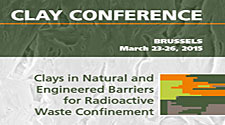
Steven Benbow, Kate Thatcher, Claire Watson and James Wilson attended the 6th International Conference on Clays in Natural and Engineered Barriers for Radioactive Waste Confinement in Brussels on the 23rd to 26th of March 2015. The conference was organised by ONDRAF/NIRAS (Belgium) in cooperation with Andra (France), COVRA (The Netherlands), Nagra (Switzerland), NWMO (Canada), Posiva (Finland) and SKB (Sweden). Clays are exploited in most geological disposal concepts for radioactive waste, either as the host rock or as material for engineered barriers. The natural characteristics of clays make them extremely good buffers to the migration of contaminants towards the surface and as host rocks they are hydrogeologically, geochemically and mechanically stable over geological timescales. The conference covered a wide range of clay-related issues, from the micro-structure of porosity to large-scale in situ experiments.
Steven Benbow gave an oral presentation on coupled thermal, hydrological and chemical (THC) modelling undertaken by Quintessa on behalf of STUK, the Finnish regulators. This study considered whether models of clay-based engineered barriers based only on illitization and cation exchange capture all the key controls on changes in the physiochemical properties of the evolving buffer. It concluded that models based on kinetic assumptions suggest some montmorillonite dissolution and alteration is possible where the clay buffer is in contact with flowing features in the host rock. Other processes such as fracture blocking by precipitating secondary minerals could also be important.
Quintessa also gave poster presentations on modelling bentonite resaturation and swelling (undertaken as part of the DECOVALEX project), multiscale approaches for whole-repository modelling (undertaken for Andra), reactive transport simulations of steel-bentonite interactions (undertaken for JAEA), modelling steel corrosion in the presence of claystone as observed in the in situ MCO experiment (undertaken for Andra) and long-term clay mineralogical evolution (in association with Savage Earth Associates).
James Wilson was co-chair of the session on metal alterations, which contained a number of interesting talks, largely concerned with iron-bentonite interactions. There has been much progress made in this area since the first conference in this series in 2002, with research into some aspects ongoing.
Further details of the conference can be found on the conference website, including extended abstracts. Full papers will appear in Clay Minerals and a new GeolSoc Special Publication.
The next meeting in the series will be held in September 2017 in Davos, Switzerland.